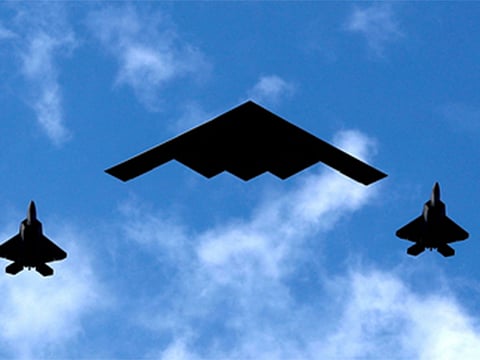Iran-Israel conflict: What are B-2 bombers and bunker busters? Why were they used?
Stealth, speed and shock: Inside the US B-2 strike on Iran’s nuclear bunkers

Dubai: In a major escalation, the United States has launched precision air strikes on Iran’s most critical nuclear sites, joining Israel in a powerful show of military force.
US President Donald Trump confirmed the strikes on his Truth Social platform, announcing that the US had bombed three key Iranian nuclear facilities — Fordow, Natanz, and Esfahan — using advanced American weaponry.
“All planes are now outside of Iran air space,” Trump said. “A full payload of BOMBS was dropped on the primary site, Fordow.”
The strikes involved the most sophisticated assets in the US arsenal, including B-2 Spirit bombers, GBU-57 bunker busters, Tomahawk cruise missiles, F-22 Raptors, and F-35A Lightning fighters. Here's a closer look at each weapon used — and why.
What are B-2 bombers?
Built by Northrop Grumman, the B-2 Spirit is the world’s most advanced stealth bomber. Its radar-evading design allows it to fly deep into enemy territory undetected, making it ideal for striking fortified targets like underground nuclear bunkers.
The B-2 can carry over 40,000 pounds of munitions, including the 30,000-pound GBU-57 Massive Ordnance Penetrator. With a range of over 6,000 nautical miles, it can take off from US soil and reach virtually any global target with aerial refuelling.
These bombers were used to target Iran’s heavily fortified Fordow site, which lies deep inside a mountain. No other aircraft could have delivered such a powerful strike with stealth, precision, and survivability.
What is the GBU-57 bunker buster? Why was it used?
The GBU-57A/B Massive Ordnance Penetrator is the most powerful conventional bomb in the US arsenal. Weighing 30,000 pounds, it can burrow through 200 feet of reinforced concrete before exploding.
This bomb was specifically designed to destroy hardened, underground military facilities — exactly like Iran’s nuclear research sites. According to reports, 12 such bombs were dropped, especially on Fordow.
What are Tomahawk cruise missiles?
Tomahawks are long-range cruise missiles launched from submarines and ships. Capable of flying low to the ground and changing targets mid-flight via satellite, they are ideal for precision strikes from a distance.
Thirty Tomahawk missiles were reportedly launched from US Navy submarines in the Gulf, targeting infrastructure and defense systems at Natanz and Esfahan. These missiles offer a stand-off strike capability without putting pilots at risk.
What are F-22 raptors?
The F-22 Raptor is the US Air Force’s premier air dominance fighter. Known for its stealth, speed, and agility, it can evade radar and defeat threats before they reach the bombers.
F-22s were deployed to provide top-cover, neutralizing any potential Iranian aerial response during the operation.
What is the F-35A lightning II?
A fifth-generation fighter jet, the F-35A combines stealth with real-time battlefield awareness. It can carry out high-precision strikes in all weather while communicating seamlessly with other aircraft.
The F-35A was used to support the mission’s second wave, enhancing strike accuracy and ensuring operational coordination across assets.
With all aircraft returning safely, the US operation delivered a strong message: No target is beyond reach — and no underground facility is too deep. Whether it marks a turning point toward wider conflict or opens a path to peace remains to be seen.
Sign up for the Daily Briefing
Get the latest news and updates straight to your inbox




